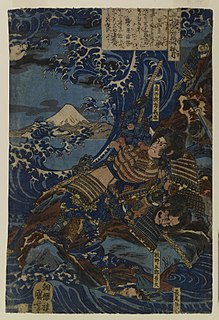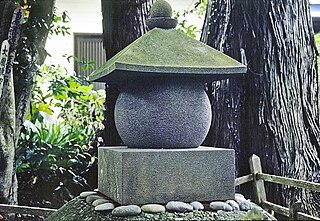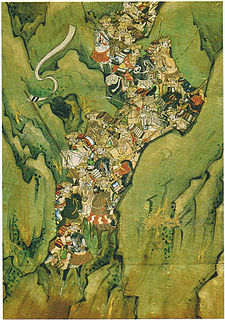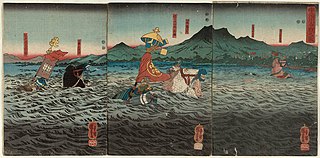
Kamakura Gongorō Kagemasa (鎌倉権五郎景政) (born 1069) was a samurai descended from the Taira clan, who fought for the Minamoto clan in the Gosannen War of Japan's Heian period. He is famous for having continued to fight after losing an eye in battle during that war. This was in 1085, [1] when Kagemasa was sixteen years of age. [2] [3]

Taira clan was a major Japanese clan of samurai.
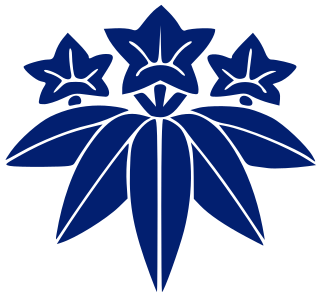
Minamoto (源) was one of the surnames bestowed by the Emperors of Japan upon members of the imperial family who were excluded from the line of succession and demoted into the ranks of the nobility from 1192 to 1333. The practice was most prevalent during the Heian period, although its last occurrence was during the Sengoku period. The Taira were another such offshoot of the imperial dynasty, making both clans distant relatives. The Minamoto clan is also called the Genji (源氏), using the on'yomi reading for Minamoto.
The Gosannen War, also known as the Later Three-Year War, was fought in the late 1080s in Japan's Mutsu Province on the island of Honshū.
The progenitor of the Nagae and Kagawa clans, Kagemasa is also claimed as an ancestor by Ōba Kagechika, a famous figure of the Genpei War (1180–1185). The family name "Kamakura" comes from his family's residence in the city of Kamakura (in today's Kanagawa Prefecture), where his father was a powerful official. The exact identity of his father is unclear, but most scholars cite either Taira no Kagenari or Taira no Kagetōri as likely names.
Kagawa clan was a rather minor Japanese clan during the Sengoku period of Japan. Throughout the course of the Sengoku period, the Kagawa family had very strong bonds with the powerful clan of Chōsokabe, in which they had at many times received members from the Chosokabe family as used for adoptive survival. After the Chosokabe clan went relatively extinct due to their rebellions against the Tokugawa Shogunate during the Edo period, the Kagawa clan died out.
Ōba Kagechika, also known as Ōba Saburō Kagechika, was a samurai of Japan's Heian period. The third son of Oba Kageyoshi, he fought alongside his father, against the Minamoto Clan, in the Hōgen Rebellion of 1156.

The Genpei War (1180–1185) was a national civil war between the Taira and Minamoto clans during the late-Heian period of Japan. It resulted in the downfall of the Taira and the establishment of the Kamakura shogunate under Minamoto no Yoritomo in 1192.

Kamakura Gongorō Kagemasa is the hero of the kabuki play Shibaraku , one of the most widely recognized of all kabuki roles and one most associated with the form among those with only a cursory knowledge of the form. Kagemasa is represented in the play with bold red and white face makeup, and a massive costume with huge sleeves, often bearing the crest of the actor Ichikawa Danjūrō.

Kabuki (歌舞伎) is a classical Japanese dance-drama. Kabuki theatre is known for the stylization of its drama and for the elaborate make-up worn by some of its performers.

Shibaraku is a play in the Kabuki repertoire, and one of the celebrated Kabuki Jūhachiban. The flamboyantly dramatic costume and makeup (kumadori) used in this scene is famous and associated by the average Westerner with Kabuki in general. The English translation of the title is akin to "Stop a Moment!"

Kumadori (隈取) is stage makeup worn by kabuki actors, particularly when performing in the bold and bombastic aragoto style. Kumadori makeup generally consists of brightly colored stripes or patterns over a white foundation, the colors and patterns symbolizing aspects of the actor's character. Though kumadori was originated and developed extensively by members of the Ichikawa Danjūrō line of actors, some conventions are creations of the Onoe Kikugorō line.





